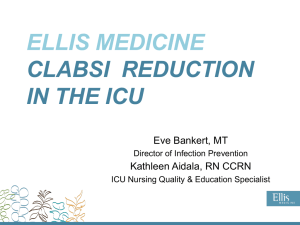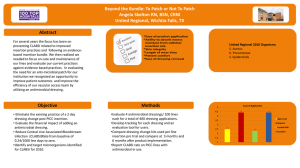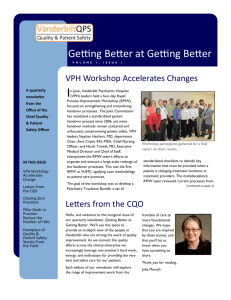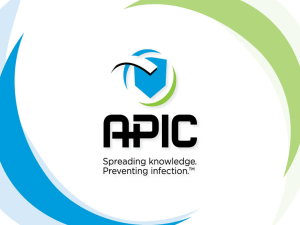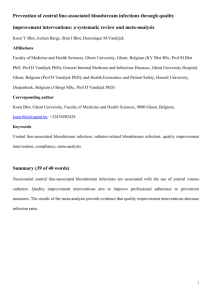File - Victoria DesJardins
advertisement
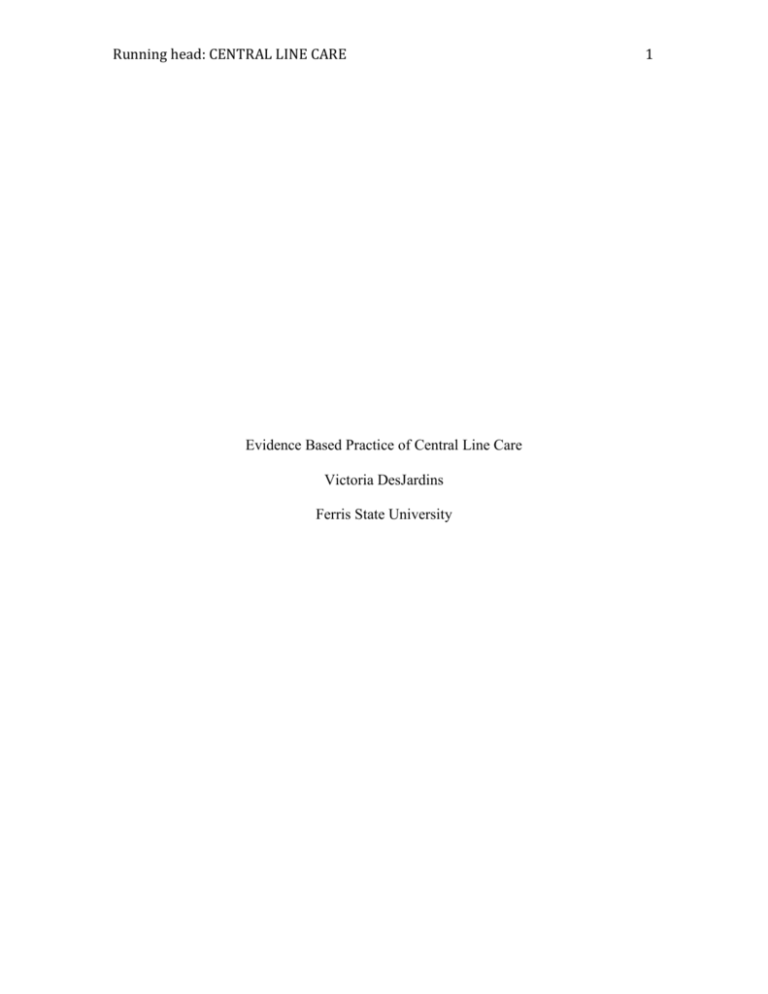
Running head: CENTRAL LINE CARE Evidence Based Practice of Central Line Care Victoria DesJardins Ferris State University 1 2 CENTRAL LINE CARE Safety Associated with Central Line Care Central line associated blood stream infections, or CLABSI’s, can be a very serious problem in healthcare. A central line is similar to a common peripheral venous catheter, but has a longer catheter ending in the central venous circulation (Taylor, Lillis, LeMone & Lynn, 2011). Because these catheters provide direct access to the heart, CLABSI’s are considered to be high-risk and life threatening if left untreated (Morrison, 2012). Fortunately these infections are very preventable with the proper care and education. Using evidence based practice; researchers are coming up with the most appropriate way to care for central lines, with regards to preventing unnecessary infections. CLABSI’s are linked to an increase in length of stay, mortality, and morbidity (Kime, Mohsini, Nwankwo & Turner, 2011). Since these infections are preventable and known as hospital acquired, they usually end up costing the hospital money. Morrison estimates that one CLABSI costs the hospital about $25,000 (2012). Most hospitals have protocols in place pertaining to central line care. Unfortunately some of these protocols are not assembled using evidence based practice, and therefor are not preventing CLABSI’s. Recently there has been an increase in evidence-based information dealing with central line care. There are many different aspects to caring for central lines and it is important, to ensure the safety of our patient, that we perform these tasks in the best way that reduces the risk of infection. In a guideline that was recently produced by the CDC, based on evidence-based research, it laid out different characteristics of care that showed a decrease in CLABSI’s (Bianco, Coscarelli, Nobile, Pileggi & Pavia, 2013). Hand hygiene, maximal barrier protection, chlorhexidine antiseptic use, catheter site placement, CENTRAL LINE CARE 3 and removal of lines when they are no longer necessary showed to be the main elements of care that can help prevent infection (Bianco et al., 2013). Coincidentally, the factors that are believed to cause CLABSI’s are lack of adequate hand hygiene, improper sterile technique, lack of education of central line care, and insufficient standardized approach to central line dressing changes (Kime et al., 2011). It is very important to practice proper hand hygiene before any patient procedure, especially with one that involves direct venous access to the many circulatory veins of the heart. Research has showed that compliance with proper hand hygiene can make a significant change in reducing CLABSI’s (Kime et al., 2011). While performing care on a central line, it is also important to take the appropriate steps to ensure there are barriers between the insertion site and bacteria that may be present in the room. Evidence based research shows that suitable preventable practice is to ask the patient to wear a mask, along with the worker performing the care. This helps prevent bacteria from breathing from getting into the exposed line during a dressing change. Changing the dressing on the central line plays a major role in preventing infections. Dressing changes should occur 24 hours after placement, along with every three to seven days (Taylor et al., 2011). To enable disciplined dressing change compliance, it is important that the dressing be labeled with the date and initials so other staff is aware when it is time for the dressing to be changed (Bianco et al., 2013). It is also important to change the dressing if it has become soiled in blood or becomes loose, exposing the insertion site to room air, increasing the risk for infection (Morrison, 2012). Many hospitals have a protocol in place to ensure that staff members use correct sterile CENTRAL LINE CARE 4 technique while changing the dressing on a central line. Using sterile technique further prevents the risk for infection, along with using the proper materials for the dressing. Research by Morrison (2012) found that may nurses believed that the products that were used while providing central line care was partly to blame for the infections. In a study done by Kime, Mohsini, Nwankwo, and Turner (2011) they found that the use of Chlorhexidine over alcohol for cleaning the tubing and scrubbing the site, greatly decreased the amount of CLABSI’s at the facility. Evidence-based research has also found that the use of chlorhexidine to clean the skin before insertion and during a dressing change also helps with the prevention of CLABSI’s (Bianco et al., 2013). It was also significant to mention the proper practice of cleaning the port before drawing off the line or using it for medication delivery. Chlorhexidine is also the antiseptic of choice for cleaning the port to prevent infections. Some facilities are also beginning to use a device that is a little disc, comprised of an antimicrobial, which lies on the insertion site. This becomes another barrier and further prevents the risk of infection. Some researchers found that the placement of the central line can play a role in the risk of infection. In a study performed by Bianco and fellow researchers (2013), it was found that there was a decrease risk for infection when central lines were placed in the subclavian, opposed to a femoral or jugular site. Further evidence-based research has shown an increase risk for infection in patients who have multiple central lines in place simultaneously (Scheithauer et al., 2013). This is particularly common in the intensive care unit, where it is familiar for patients to have more than one central line site. The researchers also found that having more that one central line at a time has also shown to CENTRAL LINE CARE 5 increase morbidity, further increasing the patients likelihood of contracting a CLABSI (Scheithauer et al., 2013). Another factor in preventing CLABSI’s in patients is the removal of unnecessary central lines. After interviewing health care workers, Bianco and colleagues (2013) found that central lines were staying in place for long after they were no longer needed. This is a major factor in causing infections. Research shows that the longer a central line is in use, the more prone to infection the patient is (Scheithauer et al., 2013). Therefore, central lines should be removed as soon as there is no longer a use for them, lowering the risk of infection for that patient. Having a line in your body acts as a breeding ground for bacteria as long as acting as a direct route into the bloodstream. Although there was not a lot of evidence-based research done on central line care before, there has been a dramatic increase in the recent years. This increase of curiosity may be related to the increase awareness of CLABSI’s in the health care world. Although they are preventable infections, they are becoming a problem for hospitals and decreasing the safety of patients. In spite of CLABSI’s being harmful infections, they have opened our eyes to flaws in some of our protocols and have enabled us to learn more about how to prevent them and what the best way to accomplish that is. The abundance of recent research on this subject has enabled health care facilities to come up with appropriate protocols using evidence-based research. Providing proper care and education about CLABSI’s is very important in keeping our patients safe and preventing unnecessary infections. In order to perform good quality of care to patients, it is critical to enable every health care provider to be well 6 CENTRAL LINE CARE educated in promoting preventative measures in central line care. These steps will result in a decrease in CLABSI’s, along with other hospital acquired infections. References Bianco, A., Coscarelli, P., Nobile, C., Pileggi, C., & Pavia, M. (2013). The reduction of risk in central line-associated bloodstream infections: Knowledge, attitudes, and evidence-based practices in health care workers. American Journal of Infection Control, 41, 107-112. Kime, T., Mohsini, K., Nwankwo, M., & Turner, B. (2011). Central line "attention" is their best prevention. Advances in Neonatal Care, 11(4), 242-248. Morrison, T. (2012). Qualitative analysis of central and midline care in the medical/surgical setting. Clinical Nurse Specialist: The Journal For Advanced Nursing Practice, 26(6), 323-328. doi: 10.1097/NUR.0b013e31826e3f2a Scheithauer, S., Häfner, H., Schröder, J., Koch, A., Krizanovic , V., Nowicki , K., Hilgers , R. D., & Lemmen, S. (2013). Simultaneous placement of multiple central lines increases central line associated bloodstream infection rates. American Journal of Infection Control, 41, 113-117. Taylor, C. R., Lillis, C., LeMone, P., & Lynn, P. (2011). Fundamentals of nursing: The art and science of nursing care. (7). Philadelphia, PA: Lippincott Williams & Wilkins.
